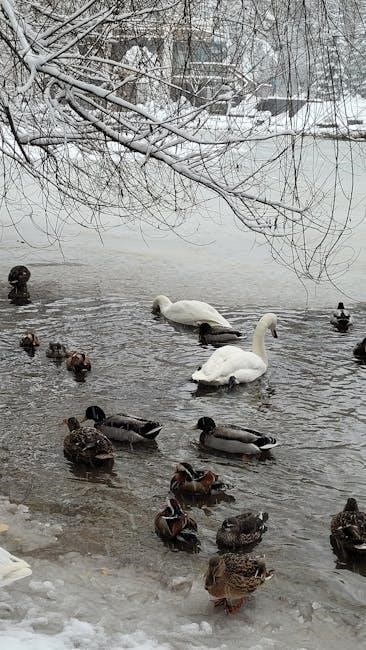Cold weather toolbox talks are essential for promoting workplace safety during winter. They provide insights into OSHA guidelines‚ environmental factors like low temperatures and wind‚ and strategies to prevent cold-related stress. These discussions help prepare workers for harsh conditions‚ ensuring awareness and safety. Regular talks can prevent incidents and foster a safer work environment.

Understanding Cold-Related Stress
Cold-related stress occurs when the body cannot maintain its temperature. Environmental factors like low temperatures‚ wind‚ dampness‚ and cold water contribute to this condition. Two or more factors increase health risks.
Environmental Factors Contributing to Cold Stress
Cold stress is influenced by four primary environmental factors: low temperatures‚ wind‚ dampness‚ and cold water. These elements can combine to increase the risk of cold-related illnesses. Low temperatures reduce the body’s ability to maintain heat‚ while wind accelerates heat loss through wind chill. Dampness and cold water further exacerbate heat loss by conducting it away from the body more efficiently. When two or more of these factors are present‚ the risk of cold stress increases significantly. For example‚ a temperature of 30°C with a 16 km/h wind can feel much colder due to wind chill‚ increasing the likelihood of frostbite and hypothermia. Understanding these environmental factors is crucial for preventing cold-related stress and ensuring worker safety in cold conditions.
Medical Conditions Resulting from Cold Exposure
Prolonged exposure to cold weather can lead to serious medical conditions‚ primarily frostbite and hypothermia. Frostbite occurs when skin and underlying tissues freeze due to extreme cold‚ often affecting extremities like hands‚ feet‚ and ears. It can cause numbness‚ tingling‚ and pale or blue-gray skin. If untreated‚ frostbite can lead to permanent tissue damage or amputation. Hypothermia‚ on the other hand‚ happens when the body’s core temperature drops below 95°F (35°C)‚ disrupting normal bodily functions. Symptoms include shivering‚ confusion‚ slurred speech‚ and drowsiness. Severe hypothermia can result in unconsciousness and even death. Both conditions require immediate medical attention to prevent long-term health consequences. Recognizing these signs is critical for ensuring timely intervention and safeguarding workers in cold environments. Employers and employees must be vigilant about these risks to maintain workplace safety during cold weather.
OSHA Guidelines for Cold Weather Safety
OSHA provides winter weather safety resources to help employers protect workers. While there’s no specific cold-weather standard‚ employers must ensure safe conditions and address cold-related hazards to prevent illnesses and injuries.
OSHA’s Winter Weather Safety Resources
OSHA offers comprehensive winter weather safety resources to help employers and workers stay safe in cold conditions. Their official website provides detailed guides on preventing cold-related illnesses‚ such as frostbite and hypothermia. Additionally‚ OSHA’s On-Site Consultation Program offers free‚ confidential assistance to employers to identify and mitigate workplace hazards. These resources emphasize the importance of proper clothing‚ hydration‚ and regular breaks in cold environments. They also address vehicle safety‚ highlighting the risks of under-inflated tires and icy surfaces. Employers are encouraged to use these materials to conduct toolbox talks‚ ensuring workers are well-prepared for winter challenges. By leveraging OSHA’s resources‚ workplaces can reduce the risks associated with cold weather‚ fostering a safer and healthier environment for everyone. These guidelines are particularly crucial for industries where outdoor work is unavoidable‚ ensuring compliance with safety standards and promoting overall worker well-being.

Preparing for Cold Weather
Preparing for cold weather involves checking equipment‚ wearing layered clothing‚ and ensuring proper hydration. Employers should conduct regular safety checks and provide training on cold-weather risks to prevent incidents.
Vehicle Safety in Cold Conditions
Vehicle safety in cold conditions is crucial to prevent accidents and ensure smooth operations. Cold weather can affect tire pressure‚ traction‚ and overall vehicle performance. Under-inflated tires‚ icy patches‚ and poor traction are significant risks‚ impacting both cars and heavy equipment. Regular maintenance checks are essential to ensure vehicles are winter-ready. This includes inspecting tires‚ brakes‚ and fluid levels. Drivers should also carry emergency kits with items like ice scrapers‚ blankets‚ and flashlights. Employers should emphasize the importance of reducing speed and increasing following distances in icy conditions. Additionally‚ vehicles should be equipped with winter tires or chains if operating in extreme cold. Proper preparation and awareness can significantly reduce the likelihood of accidents and downtime. Encourage drivers to stay alert and report any vehicle issues promptly. Employers should provide resources and training to ensure all employees are prepared for cold-weather driving challenges.

Personal Protective Equipment for Cold Weather

Personal protective equipment (PPE) is vital for safeguarding workers in cold environments. Layering clothing is essential‚ starting with a moisture-wicking base layer‚ followed by insulating mid-layers‚ and ending with a waterproof and windproof outer layer. Hats‚ scarves‚ and neck gaiters help prevent heat loss‚ while insulated‚ waterproof gloves or mittens protect hands. Face masks or balaclavas can shield skin from wind and frostbite. Waterproof‚ insulated boots with good traction are crucial to prevent slips on icy surfaces. Employers should ensure PPE is readily available and that workers understand its proper use. Additionally‚ eyewear with anti-fog coating can improve visibility in snowy or icy conditions. Regularly checking PPE for damage or wear is important to maintain its effectiveness. By prioritizing PPE‚ employers can help reduce the risk of cold-related injuries and ensure worker safety during harsh winter conditions.
Cold Weather Safety Practices

Monitor weather conditions‚ use proper PPE‚ and stay hydrated to prevent cold-related stress. Employers should ensure workers take regular breaks in warm areas and maintain open communication to address safety concerns promptly.

Work Schedule Adjustments for Cold Conditions
Adjusting work schedules during cold weather is crucial to ensure worker safety. Employers should consider altering start times to avoid extreme cold‚ reduce exposure during the coldest parts of the day‚ and increase supervision. Rotating tasks and providing regular breaks in warm areas can help prevent cold-related stress. OSHA recommends monitoring weather conditions and adjusting workloads accordingly. Employers should also ensure workers are hydrated and aware of the risks of cold exposure. By implementing these adjustments‚ workplaces can minimize the likelihood of cold-related illnesses and maintain productivity. Proper scheduling and breaks help workers stay safe and focused‚ reducing the risk of accidents. Employers must take proactive steps to protect employees in harsh winter conditions‚ as OSHA guidelines emphasize the importance of preventing cold stress through effective work schedule management.
Importance of Hydration in Cold Weather
Hydration is often overlooked in cold weather‚ but it is just as critical as in hot conditions. Cold environments can lead to dehydration due to increased urine production‚ dry air‚ and higher energy expenditure to stay warm. Workers may not feel thirsty‚ but their bodies still lose moisture‚ risking dizziness‚ confusion‚ and reduced physical performance. Dehydration can also increase the risk of hypothermia and frostbite‚ as the body struggles to regulate its temperature. Employers should emphasize the importance of drinking water regularly‚ even in cold conditions. Encouraging workers to consume warm‚ non-caffeinated fluids and eat water-rich foods can help maintain hydration levels. Additionally‚ avoiding alcohol and caffeine‚ which dehydrate the body‚ is crucial. Regular breaks in warm areas can provide opportunities to hydrate and rest. Proper hydration is essential for maintaining focus‚ preventing accidents‚ and ensuring overall health in cold weather work environments.

Cold Weather Emergency Preparedness
Cold weather emergency preparedness involves having a plan‚ supplies‚ and communication devices ready. Ensure access to warm shelters‚ blankets‚ and first aid kits to address potential cold-related incidents promptly and effectively.
Recognizing and Responding to Frostbite and Hypothermia
Frostbite and hypothermia are serious medical conditions caused by prolonged cold exposure. Frostbite affects skin and underlying tissues‚ causing numbness‚ discoloration‚ and pain. Hypothermia occurs when body temperature drops below 95°F‚ leading to confusion‚ shivering‚ and drowsiness. Immediate response is critical. For frostbite‚ gently warm the affected area with warm water (not hot) and avoid direct heat. For hypothermia‚ move the person to a warm place‚ remove wet clothing‚ and use blankets to rewarm. Do not rub affected areas or give alcohol. Seek medical attention promptly. Early recognition and proper first aid can prevent severe complications. Employers should train workers to identify these conditions and respond effectively to ensure workplace safety during cold weather.
Physical Health Considerations
Cold weather increases physical strain due to shivering and increased heart rate. Dehydration risks rise as fluids are lost through breathing. Proper hydration and nutrition are crucial to maintain energy and warmth.

Preventing Dehydration in Cold Environments
Dehydration in cold environments is often overlooked but can be just as dangerous as in hot conditions. Cold weather reduces thirst sensation‚ leading to inadequate fluid intake. Workers may not realize they are losing moisture through breathing and sweating‚ which can impair physical performance and judgment. To prevent dehydration‚ encourage regular sips of warm‚ non-caffeinated fluids‚ such as water or herbal tea‚ throughout the day. Avoid alcohol and caffeine‚ as they can exacerbate fluid loss. Additionally‚ eating water-rich foods like fruits and vegetables can contribute to hydration. Monitoring urine color is a simple way to assess hydration levels—pale yellow indicates proper hydration. Employers should remind workers to drink fluids regularly‚ even if they don’t feel thirsty‚ to maintain their health and safety in cold conditions.

Mental Health and Cold Weather
Cold weather can impact mental health by affecting mood and focus. Staying alert and focused is crucial for safety. Employers should promote awareness and strategies to maintain mental well-being in cold conditions.
Staying Alert and Focused in Cold Conditions
Cold weather can significantly impact mental alertness and focus‚ increasing the risk of accidents. Prolonged exposure to cold conditions can cause fatigue‚ shivering‚ and discomfort‚ all of which impair concentration. Employers should emphasize the importance of staying alert to prevent errors and injuries.
Practical strategies include taking regular breaks in warm areas‚ staying hydrated‚ and wearing appropriate clothing to maintain comfort. Employers can also promote teamwork‚ encouraging workers to monitor each other’s behavior for signs of cold-related fatigue. Additionally‚ clear communication and simplified tasks can help reduce mental strain in cold environments.
By fostering a culture of safety and awareness‚ employers can help workers stay focused and alert‚ minimizing the risks associated with cold weather. Regular training and resources on mental health in cold conditions further support overall workplace safety and productivity.
Cold weather toolbox talks are crucial for ensuring workplace safety during winter months. They provide essential insights into preventing cold-related stress‚ recognizing medical conditions like frostbite and hypothermia‚ and adhering to OSHA guidelines. By understanding environmental factors such as low temperatures and wind chill‚ workers can better protect themselves. Employers should emphasize the importance of proper preparation‚ including personal protective equipment and vehicle safety‚ while also encouraging hydration and adjusted work schedules. Mental health and staying alert in cold conditions are equally vital to prevent accidents. Regular discussions and resources‚ such as OSHA’s Winter Weather Safety page‚ can help employers create a safer work environment. Ultimately‚ these talks empower workers to navigate cold conditions effectively‚ reducing risks and fostering a culture of safety and awareness.

